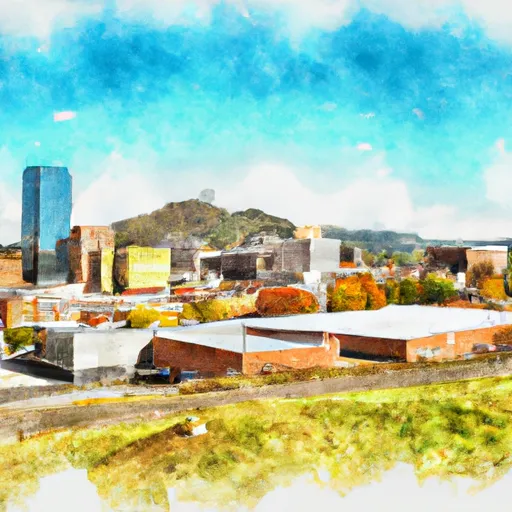-
 Snoflo Premium
Snoflo Premium
Get unlimited access to all our content
With no Ad interruptions! - Start Your Free Trial Login with existing account
Johnson-City
Eden Index
Climate
8.3
•
Recreation
5.5
•
Community
2.7
•
Safeguard
5.9/10

Johnson City is a vibrant city nestled in the rolling hills of northeastern Tennessee. Known for its moderate climate, the city experiences four distinct seasons. Summers are warm and humid, with temperatures averaging around 85°F, while winters are mild with average temperatures around 45°F. Johnson City boasts a pleasant and comfortable climate for most outdoor activities throughout the year.
The city is surrounded by beautiful natural landscapes, including several rivers and lakes. The Watauga and Nolichucky Rivers are popular destinations for fishing, kayaking, and canoeing enthusiasts. Boone Lake provides opportunities for boating, swimming, and picnicking, while nearby Cherokee National Forest offers countless hiking trails and camping spots for nature enthusiasts.
For those seeking outdoor adventure, Johnson City is also home to several parks and recreational facilities. Buffalo Mountain Park offers miles of scenic trails and breathtaking views, while Winged Deer Park features baseball fields, soccer fields, and a disc golf course. Additionally, visitors can enjoy golfing at the Pine Oaks Golf Course or spend a day exploring the Tannery Knobs Mountain Bike Park.
Overall, Johnson City's inviting climate, diverse hydrology constituents, and abundance of outdoor recreational opportunities make it a haven for those who enjoy spending time in nature.
What is the Eden Index?
The Snoflo Eden Index serves as a comprehensive rating system for regions, evaluating their desirability through a holistic assessment of climate health, outdoor recreation opportunities, and natural disaster risk, acknowledging the profound impact of these factors on livability and well-being.
Climate Health Indicator (CHI): 8.3
Johnson-City receives approximately
1143mm of rain per year,
with humidity levels near 83%
and air temperatures averaging around
14°C.
Johnson-City has a plant hardyness factor of
7, meaning
plants and agriculture in this region tend to thrive during the non-winter months.
By considering the ideal temperature range, reliable water supplies, clean air, and stable seasonal rain or snowpacks, the Climate Health Indicator (CHI) underscores the significance of a healthy climate as the foundation for quality living.
A healthy climate is paramount for ensuring a high quality of life and livability in a region, fostering both physical well-being and environmental harmony. This can be characterized by ideal temperatures, reliable access to water supplies, clean air, and consistent seasonal rain or snowpacks.
Weather Forecast
Streamflow Conditions
French Broad-Holston
Area Rivers
French Broad-Holston
Snowpack Depths
French Broad-Holston
Reservoir Storage Capacity
French Broad-Holston
Groundwater Levels
Recreational Opportunity Index (ROI): 5.5
The Recreational Opportunity Index (ROI) recognizes the value of outdoor recreational options, such as parks, hiking trails, camping sites, and fishing spots, while acknowledging that climate plays a pivotal role in ensuring the comfort and consistency of these experiences.
Access to outdoor recreational opportunities, encompassing activities such as parks, hiking, camping, and fishing, is crucial for overall well-being, and the climate plays a pivotal role in enabling and enhancing these experiences, ensuring that individuals can engage in nature-based activities comfortably and consistently.
Camping Areas
| Campground | Campsites | Reservations | Toilets | Showers | Elevation |
|---|---|---|---|---|---|
| Pleasant Ridge County Park | 25 | 1,173 ft | |||
| Paris Mountain State Park | 50 | 1,061 ft | |||
| Mount Mitchell State Park | 9 | 6,258 ft | |||
| Patience Park Toe River Campground | 86 | 2,677 ft | |||
| Black Mountain | 48 | 3,005 ft | |||
| Curtis Creek | 14 | 1,876 ft | |||
| Crabtree Meadows - Blue Ridge Parkway | None | 3,751 ft | |||
| Persimmon Ridge City Park | 45 | 1,733 ft | |||
| Carolina Hemlocks | 38 | 2,750 ft | |||
| Rock Creek Rec Area | 80 | 2,348 ft |
Nearby Ski Areas
Catastrophe Safeguard Index (CSI):
The Catastrophe Safeguard Index (CSI) recognizes that natural disaster risk, encompassing floods, fires, hurricanes, and tornadoes, can drastically affect safety and the overall appeal of an area.
The level of natural disaster risk in a region significantly affects safety and the overall livability, with climate change amplifying these risks by potentially increasing the frequency and intensity of events like floods, fires, hurricanes, and tornadoes, thereby posing substantial challenges to community resilience and well-being.
Community Resilience Indicator (CRI): 2.7
The Community Resilience Indicator (CRI) recognizes that education, healthcare, and socioeconomics are crucial to the well-being of a region. The CRI acknowledges the profound impact of these elements on residents' overall quality of life. By evaluating educational resources, healthcare accessibility, and economic inclusivity, the index captures the essential aspects that contribute to a thriving community, fostering resident satisfaction, equity, and social cohesion.

